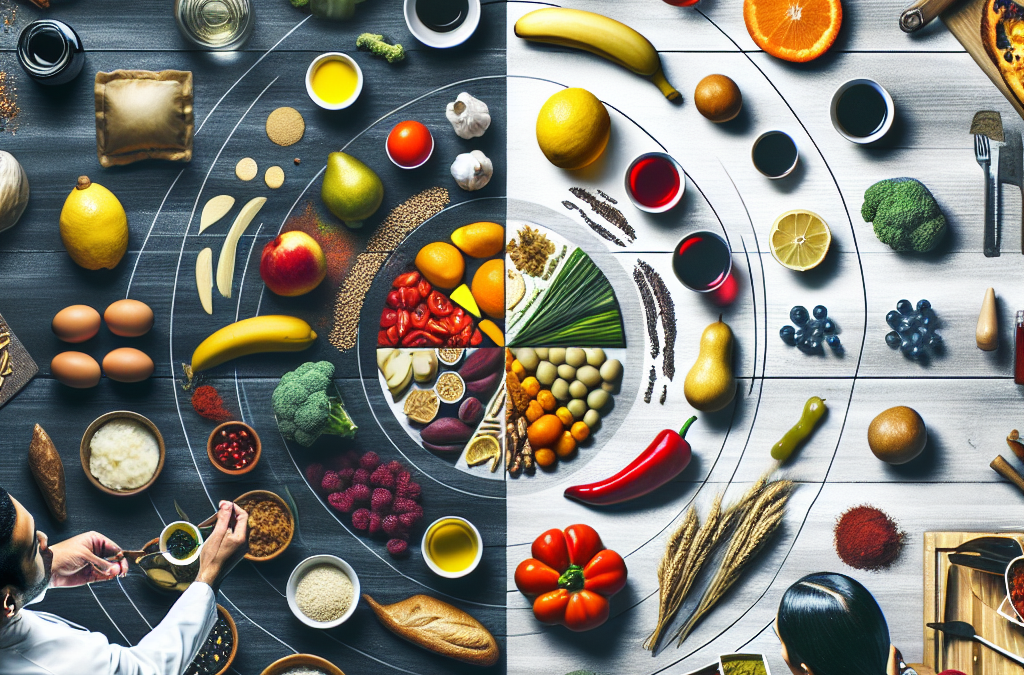Hello there! If you’re anything like me, you’ve probably spent a good chunk of your life wondering why some foods just don’t seem to go well together. As I dived deeper into cooking, nutrition, and just the good ol’ joy of eating, I discovered five major areas that made a world of difference when it came to food combinations. So, let’s roll up our sleeves and dig into this scrumptious topic!
Complementary Flavors
First up on our journey is the delicious world of complementary flavors. This is all about pairing foods that enhance each other’s natural taste. Think of peanut butter and jelly; separately they’re nice, but together they are magic!
Understanding Taste Profiles
To master complementary flavors, start by understanding the different taste profiles: sweet, salty, sour, bitter, and umami. Each profile has its own charm. For instance, sweet and salty can create a beautifully balanced dish—ever tried chocolate-covered pretzels? Those two flavors just vibe together!
Experimenting is the key here. Grab a few ingredients and pair them together. You might be surprised at what works. Maybe it’s that odd combination of pineapple with cheese that takes your taste buds on a rollercoaster!
In time, you’ll be able to anticipate which flavors go hand in hand. Just remember, taste is personal! What works for one person might not tickle the palates of another.
Texture Matters
Texture is another nifty aspect when combining foods. Mixing crispy with creamy can elevate your dish from okay to “wow.” Think about the freshness of a salad combined with crunchy nuts—it’s a party in your mouth!
Don’t be afraid to play around with different textures. Soft avocado with crunchy toast is an example of how textures beautifully contrast and complement each other. It’s about finding that balance and ensuring it’s not just one-note.
Always remember, the right texture can make even the simplest meals more enjoyable. So next time you whip up something, think about how you can add that crunchy or chewy element to contrast with something smooth.
Creating Harmony
Lastly, creating harmony in flavors is key. This means all the components of your dish should work together without overshadowing one another. If you’re making pasta, the sauce shouldn’t completely drown out the noodle—each bite should have a bit of everything!
Balancing the flavors, and even the temperatures, is crucial. Hot pasta with cold pesto can be an enticing combination. Experiment with balancing different elements until you find the perfect melody!
Strive for a harmonious plate every time you cook, and you’ll not only make your food look more appealing, but it’ll taste way better, too!
Nutritional Considerations
Nutrition is a game changer in the food world, and it plays a huge role in food combinations. Pairing certain foods can actually enhance their nutritional benefits. Yep, it’s not just about taste; it’s a health thing, too!
Synergy in Nutrients
Some foods, when eaten together, can improve the absorption of nutrients. For example, iron from spinach is better absorbed when paired with vitamin C from a splash of lemon juice. This little trick can make a huge difference in your meals!
Don’t neglect these combinations; they can boost your health game significantly. Start incorporating foods strategically—maybe a spinach salad with citrus dressing for that extra iron boost?
Being mindful of how you combine foods can lead to better health over time. Plus, it gives you more variety in your meals, keeping things fresh and exciting.
Digestive Harmony
Some foods are just better together when it comes to digestion. For instance, pairing complex carbs with protein can help your body break things down more effectively. Isn’t that something?
Also, think about food combining principles, like avoiding mixing too many proteins. Too much in your gut can be a heavy burden, leading to discomfort. Focus on having balance with your meals!
As I learned to pair foods with digestive considerations in mind, my stomach thanked me. A happy gut makes for a happy life!
Allergen Awareness
Lastly, being aware of allergens is crucial. Some foods combined can cause reactions if you’re not careful. For example, if you have a nut allergy, you’ll obviously want to steer clear of those peanut sauces!
It’s about understanding your body and what works for you. Always pay attention to how you feel after eating certain combinations. Trust me, your body is the best indicator!
Knowing what works for you will make your journey much smoother and way more enjoyable. Your health and happiness are worth it!
Classic Pairings
Now let’s sink our teeth into some classic pairings. There is a reason certain foods have stood the test of time together—because they flat-out work!
Time-Honored Combinations
There’s something so comforting about classic pairings. Think spaghetti and meatballs or fish and chips—names that immediately pop into our minds for a reason. These combos have been loved for generations!
Get an Amazing Discount on the Best Certified Organic Whole Food Supplement!
What’s great about these combinations is that they often require minimal effort while providing maximum satisfaction. It’s like returning to your childhood, tasting the familiar, and feeling all warm inside.
So next time you’re planning your meals, consider those time-honored pairs. They’ve stood the test of time for a reason—they just work!
Regional Specialties
Traveling the world through food is one of my favorite pastimes. Each region has its unique food combinations that reflect the local culture. For instance, tomatoes and basil in Italian cuisine create a vibrant burst of flavor in every dish!
Embracing these regional specialties can enhance your culinary arsenal. Trying out new combinations is like taking a mini-vacation right in your kitchen!
Consider branching out and recreating dishes from different cultures. You never know; you might stumble upon your new favorite dish!
Unexpected Twists
Sometimes, the most delightful combinations come from unexpected twists. Ever thought about putting bacon on a donut? Wild, right? But that salty-sweet contrast makes it a hit!
Think outside the box! Mixing sweet and savory flavors can lead to incredible results. There’s beauty in experimentation, so don’t shy away from trying something new!
Remember, the kitchen is your playground! Mix things up, and you might create something revolutionary next time you’re cooking!
Cooking Techniques
The way you cook can really transform food combinations. Some techniques elevate your dishes and make flavors pop, which is a total win in my book!
Heating a Meal
Cooking certain foods can enhance the natural flavors. Roasting veggies for that caramelized sweetness is one of my go-to strategies. It’s amazing how a little heat can unleash new layers of flavor!
Besides great flavor, heating can also make some nutrients more bioavailable. For instance, cooking tomatoes increases the antioxidant lycopene. It’s a win-win!
So, get those pans sizzling and see how cooking techniques can elevate your culinary combos. It’s a whole new world to explore!
Layering Flavors
Layering flavors is an art. Start with the base and gradually add ingredients. This approach is particularly great for soups and sauces! Each addition builds on the previous one, creating a symphony in every bite.
Don’t forget to season at different stages! It’s a game changer. I’ve learned that seasoning throughout the cooking process rather than all at once adds incredible depth to the dish.
Getting this technique down will make your food pop with flavor. So, let’s give it a go—you won’t regret it!
Presentation
Lastly, let’s chat about presenting our dishes. A well-plated meal can make even simple dishes look gourmet! Take your time arranging your food, adding colorful garnishes for an extra pop
It’s all about that visual appeal. People eat with their eyes first, so make it pleasing to see. I believe a beautifully plated meal can elevate the entire experience!
So next time you whip up a meal, take a moment to plate it beautifully. It’ll enhance the enjoyment for you and anyone else lucky enough to dig in!
FAQ About Food Combinations
1. What are complementary flavors?
Complementary flavors are food pairings that enhance each other’s taste. They create a delicious balance, providing a more enjoyable eating experience.
2. How do I know which foods go well together?
Experimentation is key! Start with basic combinations you know work (like tomato and basil) and gradually try mixing different elements while observing how flavors interact.
3. Can food combining affect digestion?
Absolutely! Some food combinations can make digestion easier or harder, depending on how they interact in your stomach. It’s good to pay attention to how certain combos make you feel.
4. Are there any classic food pairings I should try?
Definitely! Classic pairings like strawberries and cream, cheese and crackers, or apples and cinnamon are time-tested and super delicious!
5. How can I improve my meal presentation?
Focus on color, height, and arrangement. Use garnishes and take your time to plate each component thoughtfully. It’s all about making it look as good as it tastes!




